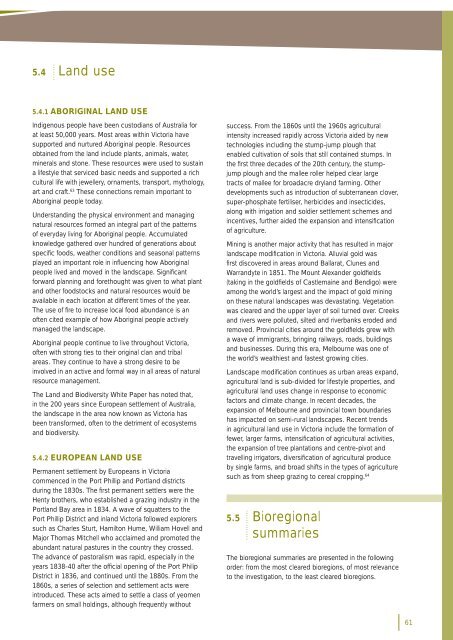findings by bioregion - Victorian Environmental Assessment Council
findings by bioregion - Victorian Environmental Assessment Council
findings by bioregion - Victorian Environmental Assessment Council
Create successful ePaper yourself
Turn your PDF publications into a flip-book with our unique Google optimized e-Paper software.
5.4 Land use5.4.1 ABORIGINAL LAND USEIndigenous people have been custodians of Australia forat least 50,000 years. Most areas within Victoria havesupported and nurtured Aboriginal people. Resourcesobtained from the land include plants, animals, water,minerals and stone. These resources were used to sustaina lifestyle that serviced basic needs and supported a richcultural life with jewellery, ornaments, transport, mythology,art and craft. 63 These connections remain important toAboriginal people today.Understanding the physical environment and managingnatural resources formed an integral part of the patternsof everyday living for Aboriginal people. Accumulatedknowledge gathered over hundred of generations aboutspecifi c foods, weather conditions and seasonal patternsplayed an important role in infl uencing how Aboriginalpeople lived and moved in the landscape. Signifi cantforward planning and forethought was given to what plantand other foodstocks and natural resources would beavailable in each location at different times of the year.The use of fi re to increase local food abundance is anoften cited example of how Aboriginal people activelymanaged the landscape.Aboriginal people continue to live throughout Victoria,often with strong ties to their original clan and tribalareas. They continue to have a strong desire to beinvolved in an active and formal way in all areas of naturalresource management.The Land and Biodiversity White Paper has noted that,in the 200 years since European settlement of Australia,the landscape in the area now known as Victoria hasbeen transformed, often to the detriment of ecosystemsand biodiversity.5.4.2 EUROPEAN LAND USEPermanent settlement <strong>by</strong> Europeans in Victoriacommenced in the Port Phillip and Portland districtsduring the 1830s. The fi rst permanent settlers were theHenty brothers, who established a grazing industry in thePortland Bay area in 1834. A wave of squatters to thePort Phillip District and inland Victoria followed explorerssuch as Charles Sturt, Hamilton Hume, William Hovell andMajor Thomas Mitchell who acclaimed and promoted theabundant natural pastures in the country they crossed.The advance of pastoralism was rapid, especially in theyears 1838-40 after the offi cial opening of the Port PhilipDistrict in 1836, and continued until the 1880s. From the1860s, a series of selection and settlement acts wereintroduced. These acts aimed to settle a class of yeomenfarmers on small holdings, although frequently withoutsuccess. From the 1860s until the 1960s agriculturalintensity increased rapidly across Victoria aided <strong>by</strong> newtechnologies including the stump-jump plough thatenabled cultivation of soils that still contained stumps. Inthe fi rst three decades of the 20th century, the stumpjumpplough and the mallee roller helped clear largetracts of mallee for broadacre dryland farming. Otherdevelopments such as introduction of subterranean clover,super-phosphate fertiliser, herbicides and insecticides,along with irrigation and soldier settlement schemes andincentives, further aided the expansion and intensifi cationof agriculture.Mining is another major activity that has resulted in majorlandscape modifi cation in Victoria. Alluvial gold wasfi rst discovered in areas around Ballarat, Clunes andWarrandyte in 1851. The Mount Alexander goldfi elds(taking in the goldfi elds of Castlemaine and Bendigo) wereamong the world’s largest and the impact of gold miningon these natural landscapes was devastating. Vegetationwas cleared and the upper layer of soil turned over. Creeksand rivers were polluted, silted and riverbanks eroded andremoved. Provincial cities around the goldfi elds grew witha wave of immigrants, bringing railways, roads, buildingsand businesses. During this era, Melbourne was one ofthe world’s wealthiest and fastest growing cities.Landscape modifi cation continues as urban areas expand,agricultural land is sub-divided for lifestyle properties, andagricultural land uses change in response to economicfactors and climate change. In recent decades, theexpansion of Melbourne and provincial town boundarieshas impacted on semi-rural landscapes. Recent trendsin agricultural land use in Victoria include the formation offewer, larger farms, intensifi cation of agricultural activities,the expansion of tree plantations and centre-pivot andtravelling irrigators, diversifi cation of agricultural produce<strong>by</strong> single farms, and broad shifts in the types of agriculturesuch as from sheep grazing to cereal cropping. 645.5 BioregionalsummariesThe <strong>bioregion</strong>al summaries are presented in the followingorder: from the most cleared <strong>bioregion</strong>s, of most relevanceto the investigation, to the least cleared <strong>bioregion</strong>s.61
















